
The CDC did not work with any (patient) swab samples or virus isolates for developing or validating the PCR test but with a mixture of a suspension of human cells and a viral transport medium (VTM) to mimic clinical specimens. The VTM often contains several ingredients such as Hanks balanced salt solution, and heat-inactivated FBS (fetal bovine serum), gentamicin sulfate, and amphotericin B. This mixture was spiked with synthetic and lab-processed particles of a chemical compound, RNA (in CDC’s terminology, “characterized stocks of in vitro transcribed full length RNA”) to assume as the SARS-COV-2 virus*. The chemical compound or particles have no link to the COVID virus, illness, or patients. This spiked mixture is used as a reference standard for the SARS-COV-2 virus, i.e., the CDC gold (reference) standard. So, CDC and others test providers look for the synthetic and lab-processed particles and tell that they are testing for the SARS-COV-2 virus.
Not only do the particles have no link to the virus, but the nature of the PCR test is such that it can detect the same or similar particles (“cases”) from different sources. Another way of saying the same thing is that the PCR test has no specificity and validity. That is why the CDC makes repeated disclaimers, in the document (Page 3, 10 & 38), concerning the lack of accuracy of the test.
*Source: CDC 2019-Novel Coronavirus (2019-nCoV) Real-Time RT-PCR Diagnostic Panel (link), p. 40

One thought on “CDC/FDA PCR test for SARS-CoV-2 – Interpretation”
Comments are closed.